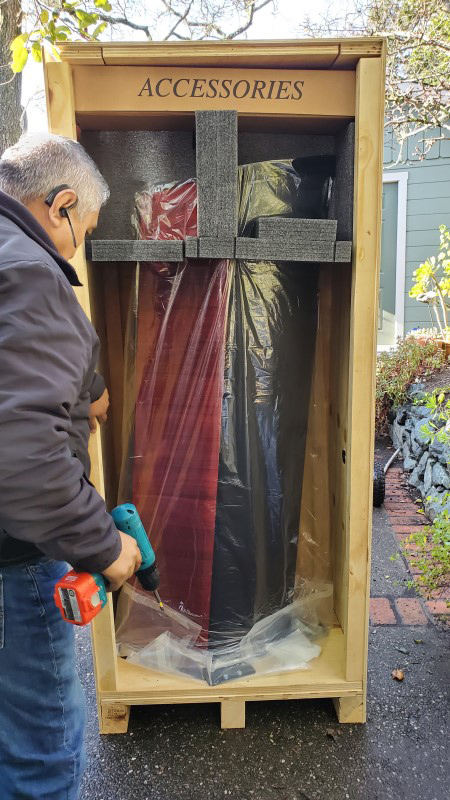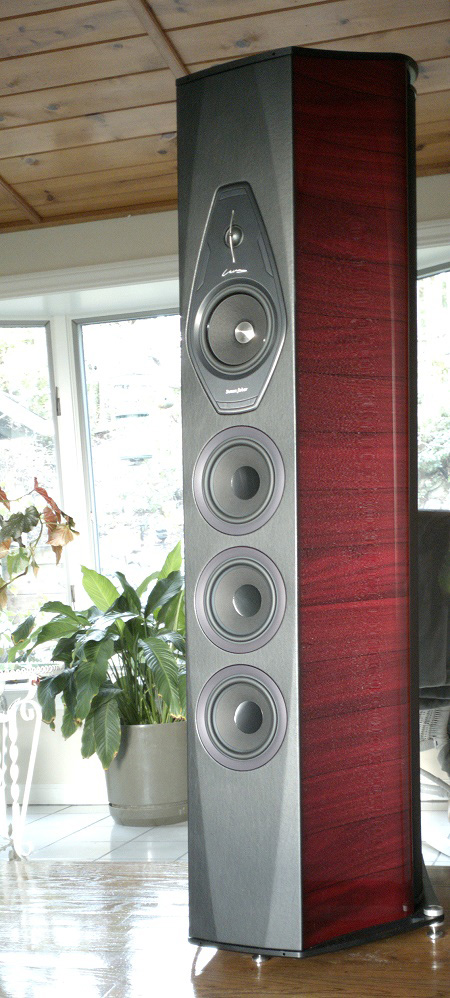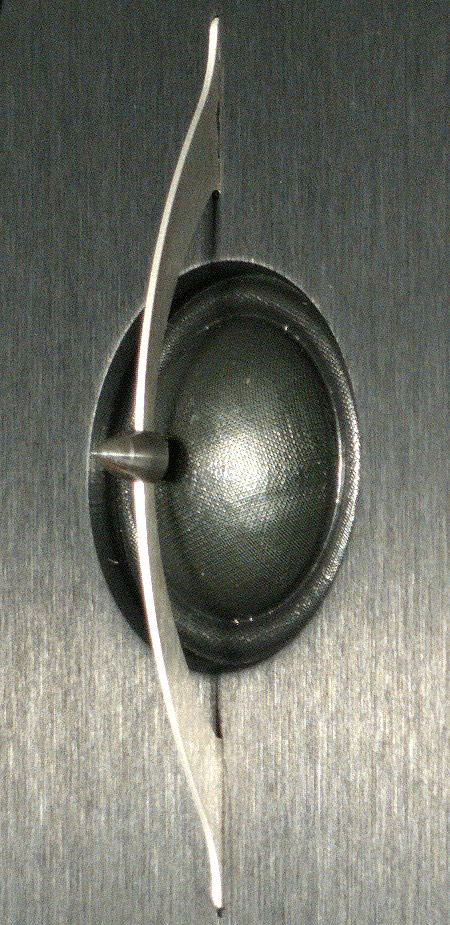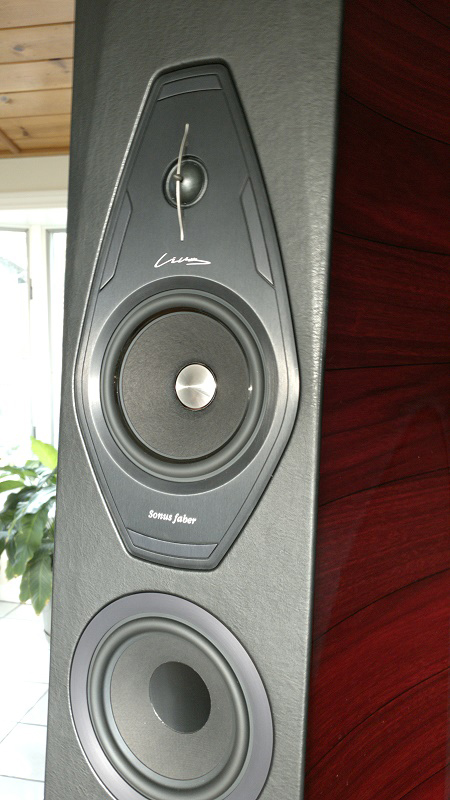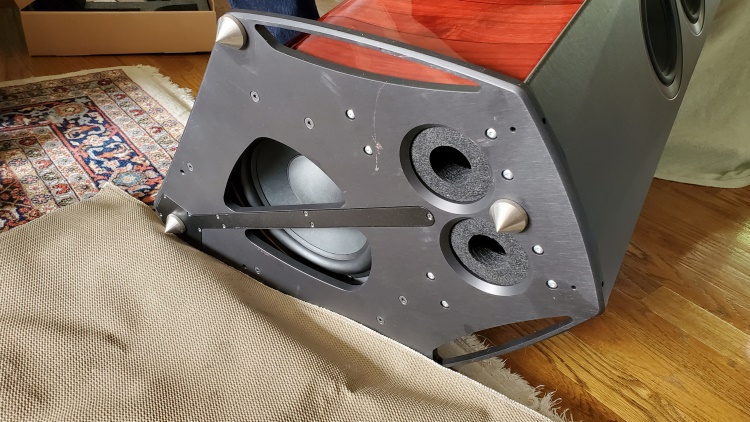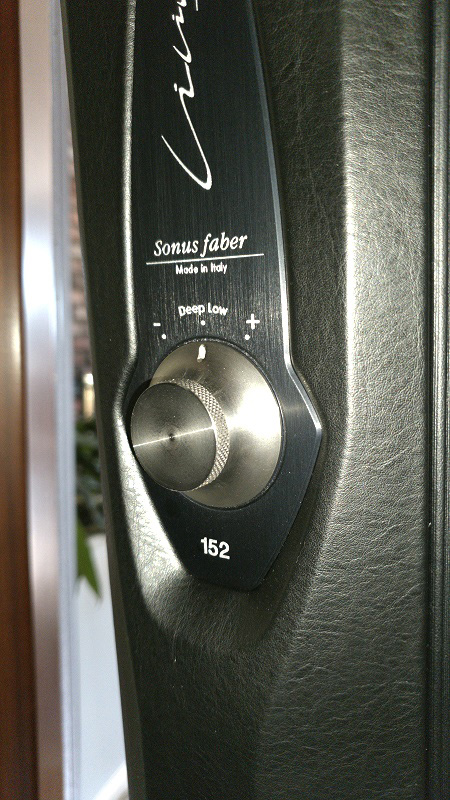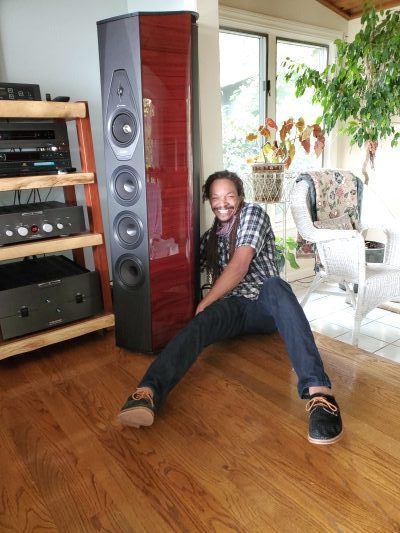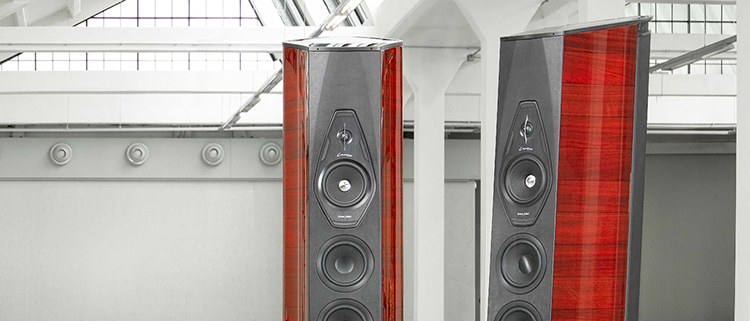
Sonus faber is a well-regarded Italian speaker company. Their staff’s engineering skills, creativity, and craftsmanship put them in the same league as their countrymen who design and build Maserati, Lamborghini, and Ferrari sports cars.
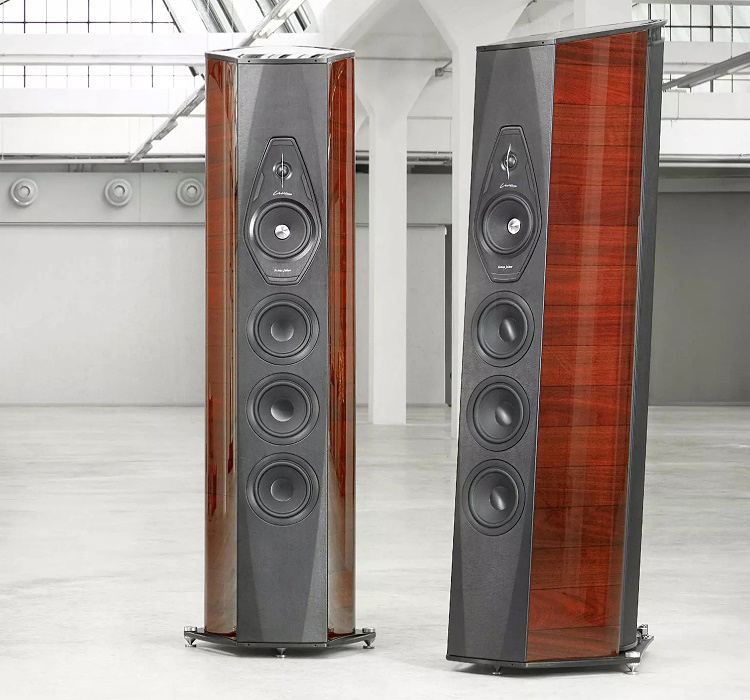
Sonus faber Lilium Floor-standing Speakers
- Amazing sound
- Fabulous construction quality
- Low distortion at high volume
- Gorgeous
SYSTEM:
3.5 way para-aperiodic vented box
DRIVERS:
Tw: H28 XTR-04 DAD Arrow Point, 28 mm
Md: M18 XTR-04 Neodymium Magnet System, 180 mm
W: 3 x W18XTR-16, 180 mm
Sw: SW26 XT-08, 260 mm
CROSSOVER FREQUENCIES:
80 Hz – 250 Hz – 2,500 Hz
FREQUENCY RESPONSE:
20 Hz – 35 kHz, Stealth reflex included
SENSITIVITY:
92 dB SPL (2.83V/1 m)
NOMINAL IMPEDANCE:
4 ohms
SUGGESTED AMPLIFIER POWER OUTPUT:
100 – 800 Watts, without clipping
DIMENSIONS (H x W x D):
63 x 19.3 x 27.7 in
1600 x 491 x 705 mm
WEIGHT:
103 Kg ea – net weight
227 Ib ea – net weight
156 Kg ea – shipping weight
344 lb ea – shipping weight
MSRP:
$75,000/pair USD
Website:
Company:
SECRETS Tags:
Sonus Faber, Lilium Speakers, Speakers, Floor Standing Speakers, Sonus Faber Speakers, Speakers Review 2020
Sonus faber is an Italian speaker company, founded in 1983 by Franco Serblin. They are headquartered in Arcugnano, Italy, and are known for very high quality in design, construction, and performance.
The Sonus faber Lilium speakers were introduced in 2014 to high praise from the audiophile community.
I wanted to expand our range of bench tests for speakers, and I thought that these extremely high-quality floor-standers would be a good choice for developing the new array. So here we go. (You can click on the small photos to see larger versions.)
The Liliums are very heavy, at 227 pounds each. They required two people to unpack them and move them into my listening room.
In the above two photos, I removed the grille from the speaker on the right channel to show the drivers more clearly. The grille consists of a series of narrow rubber “bands” arranged vertically in front of the drivers.
The Lilium is classified as 3.5-Way Aperiodic. There are seven drivers: One 28 mm tweeter, one 180 mm midrange, three 180 mm woofers, and one 260 mm subwoofer with a 260 mm passive radiator.
Here is the tweeter. You can see that it has a vertical rod that is over it’s center, top to bottom. There is a small rubber pad attached to the rod and which presses lightly on the center of the tweeter’s silk dome. This suppresses distortion that would otherwise result from the lag time that the front tip of the dome would have with respect to the rest of the dome moving back and forth with the high-frequency signals.
The crossover from the tweeter to the midrange is 2500 Hz.
In the photo below, you can see the midrange driver and one of the woofers. They are the same diameter (180 mm), but the cap in the center is different. The crossover for the mid is 250 Hz, and the crossover for the woofers is 220 Hz. This keeps the midrange from merging with the woofers that are lower on the enclosure.
The 10” subwoofer is inside the enclosure, crossing over at 80 Hz, with a 10″ passive radiator at the top of the enclosure, facing a ¼” thick piece of glass where the sound emerges from a space between the edges of the enclosure and the glass.
Shown below is the active 10” driver facing downward from the bottom of the enclosure.
And, at the top of the enclosure, the passive radiator.
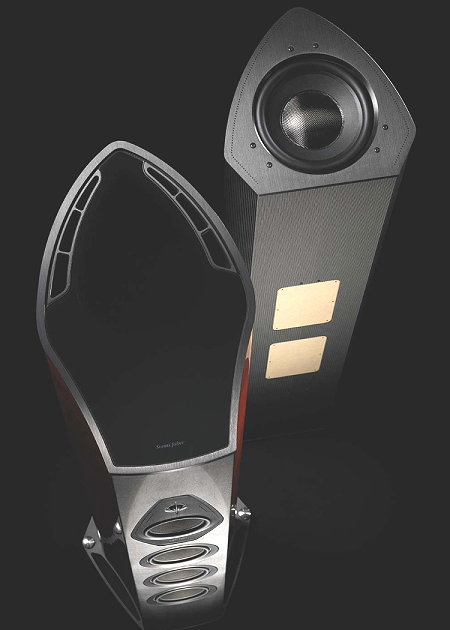
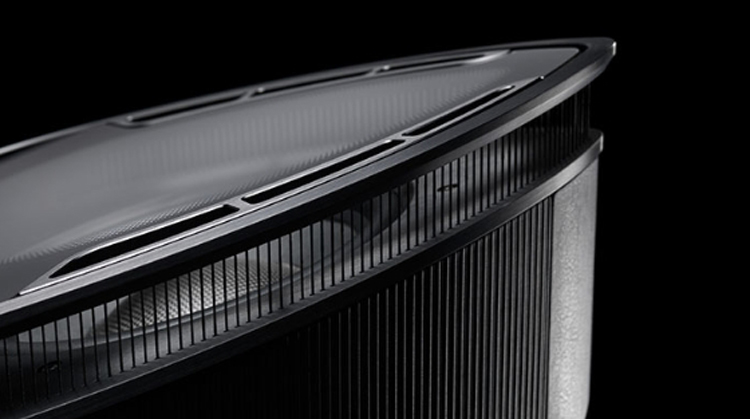
The speaker binding posts are at the base of the rear. There are three pairs of posts, for tri-wiring. To do this, you remove the connecting strips and then connect the outputs from three power amplifiers to each of the three sets of posts.
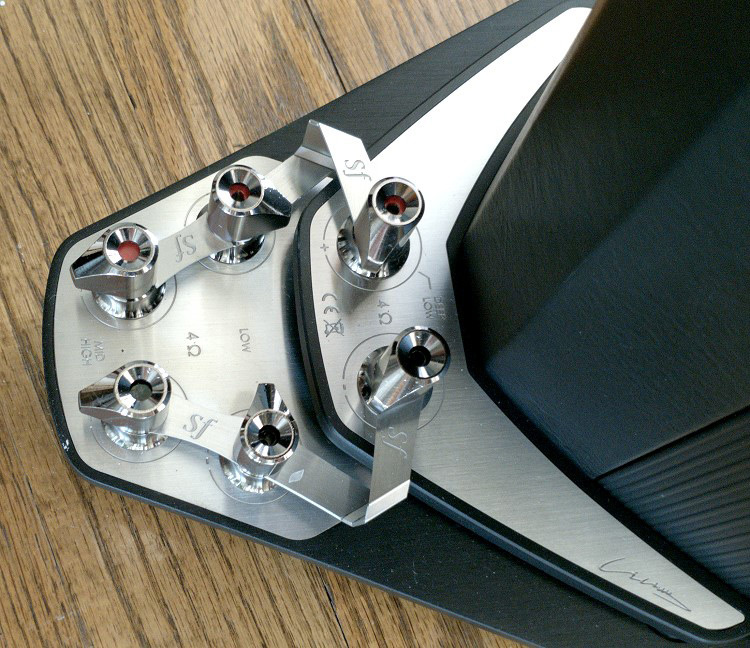
At the upper rear of the enclosure, there is a knob that is used to boost (+) or attenuate (-) the subwoofer output. The middle position is no boost or attenuation.
Each of the feet is pointed, and the point rests in an indented protective disc. This is very important as each speaker weighs 227 pounds, and if the points were allowed to rest directly on the floor, they would seriously damage the wood. When Sonus faber representative Will Kline adjusted the speakers on the floor, he started out with the pointed feet resting on pads. After he was satisfied with the placement, I held the speakers up at a slight angle while he put the protective metal discs under each pointed foot.
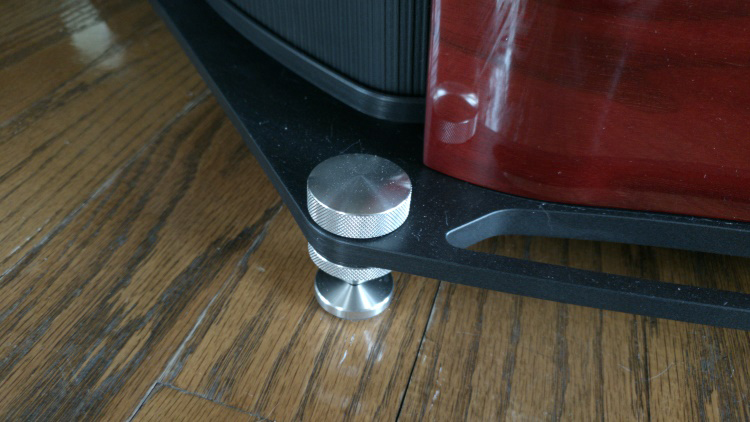
The grille is shown below. It is very transparent to the sound, and I am sure a lot of research went into its design.
The review pair were in a Red color. The enclosure is constructed from MDF rather than natural wood due to the latter’s resonance problems. The finish is a veneer covered with 12 coats of polyurethane, each of which is hand-polished before the next coat. The result is beautiful, looking like glass with wood underneath.
None of the opposing surfaces are parallel with one another. This is achieved by making each surface, except for the front baffle, curved. The non-parallel surfaces prevent standing waves from occurring inside the cabinet.
There are several other finishes available, including Walnut . . .
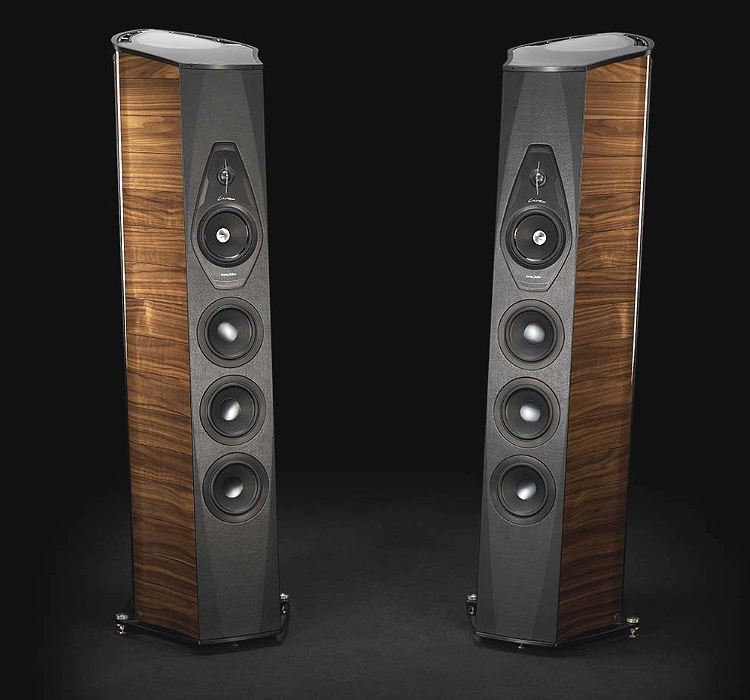
. . . and White.
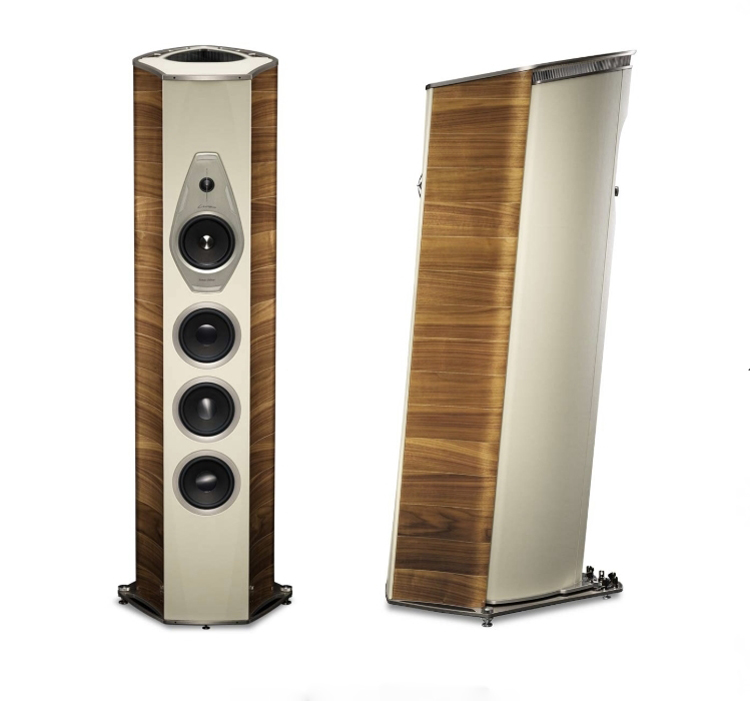
Will Kline, a manager at Sonus faber, installed the Liliums for me, aligning everything for a perfect sound presentation.
OPPO BDP-105 Universal Player (4), OPPO UDP-205 Universal Player (2), VPI-HR-X Turntable with Sumiko Blackbird MC Cartridge and Sumiko Palo Santos MC Cartridge, Manley Labs Steelhead Tube Phono Preamplifier (2), Balanced Audio Technology VK-5i Pure Class A Triode (Tube) Stereo Preamplifier (Fully Balanced), Balanced Audio Technology VK-500 Solid State Stereo Power Amplifier (Fully Balanced) (250 Watts per Channel), Pass Labs Xs Preamplifier, Pass Labs Xs 300 Monoblock Power Amplifiers (2) (300 Watts/each), Lamm LL1 Signature Stereo Pure Class A Triode (Tube) Preamplifier, MartinLogan CLX Full-Range Electrostatic Speakers, Magnepan 20.7 Planar-Magnetic Speakers, Paradigm Reference Signature SUB 2 Subwoofers (2), Custom-Built Computer for Audio Analysis, Accupel HDG-3000 Digital Color Signal Generator (1080i capable), Component Video and DVI Output, ColorFacts Pro Video Test and Calibration Software, Version 6.0, Spyder Sensor, SpectraPlus Audio Analysis Software, Audio Precision SYS-2722 Spectrum Analyzer, Staco 3PN2210B-DVM 22 Ampere Variable Transformer (for adjusting line voltage to 120 volts during amplifier power output tests), Pass Labs XP-20 Stereo Preamplifier, Classé SSP-800 Surround Sound Processor, Emotiva XMC-1 Surround Sound Processor, Classé CA-5200 Five-Channel Power Amplifier (200 Watts per Channel), Pass Labs X600.8 Power Amplifiers (4) (600 Watts/Each), Audio Control Phase Coupled Activator (Sub-Harmonic Generator), Carver Platinum Mark IV Ribbon Speakers, MartinLogan Summit X Hybrid Electrostatic Speakers (2) (Rear Left/Right), MartinLogan Stage X Hybrid Electrostatic Speakers (3) (Center and Sides Left/Right), Velodyne DD-18+ Subwoofer (3), HiFiMAN HE1000 Planar Magnetic Headphones, OPPO PM-1 Planar Magnetic Headphones, OPPO HA-1 Headphone Amplifier, Bryston BUC-1 USB Converter, Sony VPL-HW55ES 1,920 x 1,080p Digital Projector, 90″ (Diagonal) Stewart Grayhawk Projection Screen, Sony 75″ UHD Flat Panel Display, Clarus Audio and Wireworld cables, Clarus Concerto Power Conditioner with Crimson Power Cable.
Let’s begin with an old album by Art Pepper, who is one of my favorite classical jazz musicians. His instrument was an alto saxophone, and this particular album is terrific (Art Pepper meets the Rhythm Section). It is originally analog and (re-) released on vinyl but is also available in digital format. Here, it is Analogue Productions, Product No. XAPJ7532D64, DSD-64.

It became obvious very early in the review that the Sonus faber Lilium speakers really shine when the volume is cranked. I had Pepper’s sax sounding like he was playing in front of me and to the left. The clarity and detail were simply stunning.
If you like classical jazz, this is a must-have album. I have it both in re-released vinyl and digital. It helped that Will Kline, from the Sonus faber offices in Berkeley, California, had come to my home to set up the speakers, including aligning them for the best sound in my particular listening room which has an atrium behind the speakers.

This next album, Himmelrand (2L Norway, EAN-13: 7041888521723), exemplifies my love of choir music, especially old compositions from Europe and Russia. The choir here is the Church of Norway, and the recording is native DXD 24/352.8, mixed to surround sound and 24/192 PCM stereo.
Again, as above, the Liliums belted out the voices with amazing ambiance and clarity. It sounds so good, loud, there is a tendency to turn up the volume perhaps too high for the safety of one’s hearing, so you have to use common sense. Don’t indulge that capability of these speakers too often. Maybe turn up the volume to where you would really like it, and then back it off a notch or two, just for your own good.

Benjamin Britten’s Young Person’s Guide to the Orchestra is one of my favorite compositions of all time, perhaps because it was one of my first exposures to classical music recordings. This album has Britten, himself, conducting the London Symphony Orchestra, Decca 8XL6450, recorded in 1963, which is the year and version I originally purchased on vinyl.
It has not been re-issued on vinyl for some reason I do not understand as it is an amazing recording. 16/44.1 does not give the dynamic range that 24-bit digital has, and which original analog on vinyl also has. Nevertheless, it is better than not having the recording at all, and the Sonus faber Lilium speakers were up to the task. Thundering . . .

The 1960’s vinyl release of Romeo & Juliet Overture by Tchaikovsky, with Charles Munch conducting the Boston Symphony, is a treasure. I have owned it in one form or another for half a century. Even listening to it in my car gives me goosebumps. It is available in vinyl re-release as well as digital (RCA, ALSC 2565Q). Playing it using the Sonus faber Lilium speakers was yet another new experience.
I have never heard it with this level of instrument separation and room-filling volume. It was not subtle. I think all of our readers would notice this easily. In any case, this album + the Sonus faber Lilium speakers = Astonishing.

Here is a recent release (2/21/2020), Chopin Piano Concertos Nos.1 and 2, Benjamin Grosvenor, Royal Scottish National Orchestra. Piano is a difficult instrument to reproduce and have it sound realistic because several notes can be played at the same time. The slightest tonal abnormality will be obvious.
The Liliums did this fine instrument perfect justice, and this album, via Tidal streaming service (HiFi Quality which includes High Resolution such as 24/192) has been moved to my favorites folder. One thing became clear as I continued listening to these wonderful speakers: the soundstage is huge, much like planar speakers (i.e. electrostatic and planar magnetic). Very unusual. They don’t have the focused location that most cone speakers have. The entire end of the room where the speakers are located is alive with sound. The increased instrument separation I mentioned is due to the drivers being heavily engineered, but also because there are so many drivers with the signal being separated into three distinct frequency regions by the crossover networks.
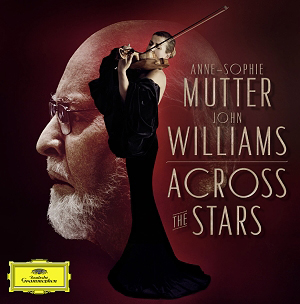
Is there anyone out there who is not a fan of the Star Wars films? Over the decades there have been many music albums that include various themes from these films. This one from Deutsche Grammophon, Across the Stars, was released on 8/30/2019 and contains not only music from those films, but several others, the themes having been composed by John Williams and played by the Recording Arts Orchestra of Los Angeles.
It has Anne-Sophie Mutter as solo violin (violin is another good test for speakers – specifically the tweeter). I listened to it via Tidal streaming.
The opening track, Rey’s Theme from The Force Awakens has some very high notes on the violin along with light taps on a triangle, and both come through with sparkling impact.
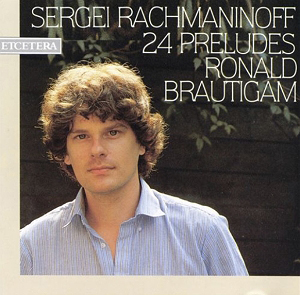
Ronald Brautigam’s Rachmaninoff 24 Preludes is a hard CD album to find, but it is worth looking for: Etcetera, B001B7GDH0. I am glad I have my copy. The Prelude No. 15 in E minor is spectacular. It sounds like Brautigam has two pairs of hands. I never realized a pianist could play so fast. The Lilium’s capability to reproduce this at a life-like volume without audible distortion is simply amazing.

Pro-ject recently (2019) released their first vinyl album, entitled 7RAY JAZZY ZOETROPE, Project PJR001. It was recorded in Austria on a vintage open reel tape recorder and mixed on a vintage mixing deck, output to tape, then to vinyl, so it is analog at every step in production. No digital anything. The music is from the European singer 7RAY plus piano, string bass, and drums.
The songs are vintage as well, such as Night and Day, and the sound is something to behold with the Sonus faber Lilium speakers. It sounded like 7RAY was literally standing in the left side of the soundstage. Very life-like. There was no audible distortion of any kind. There are two vinyl discs in this set, so the price, at $39.95, is very generous. I look forward to future Pro-jet releases.

Re-mastered vinyl from the original analog tapes is very popular right now. Some of them are re-mastered at 45 RPM which enhances the fidelity due to the approximately 35% increase in speed over the original 33-1/3 RPM. This would be especially useful at the inner-most grooves where the linear speed is less than it is at the outer grooves.
One such recording is Dear John C., Impulse Stereo A-88, Universal Music, B0015336-01, with John Coltrane’s standard drummer, Elvin Jones, originally released in 1965. It is an album dedicated to Coltrane, although the sax player, Charlie Mariano, is using an alto saxophone instead of the tenor saxophone that Coltrane used.
Here is a publicity photo of John Coltrane (Copyright Impulse Records). It was a tremendous loss when he died of cancer in 1967 at the age of 40.
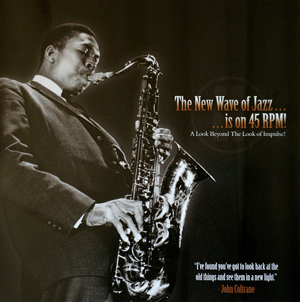
I continue to be amazed at the retention of sound quality from tapes originally recorded more than half a century ago, and I am glad to see the tapes being re-mastered to vinyl and digital now, before the inescapable eventual deterioration of the tapes beyond usability. The sound here is typical of that era, with exact localization of each instrument in the stereo soundstage.
I am a drummer (very amateur) myself, and Jones’ ride cymbal struck me with such clarity that I was truly astounded. A ride cymbal (any cymbal actually) has a very complex frequency structure, so it is no easy trick to reproduce. Wow!

Here is a spectrum from one of my ride cymbals, recorded in 24/176 sampling directly from my tapping on the cymbal. There are frequencies throughout the audible spectrum, and also up to 60 kHz. The pink spectrum is the initial tap, and the yellow spectrum is after a few seconds of decay.
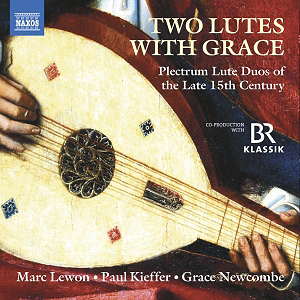
Testing transients can be done with an album of lute, guitar, or harpsichord music. Here, I used a new (February 2020) Naxos release, P-2020, entitled Two Lutes with Grace – Plectrum Lute Duos of the Late 15th Century.
When I first listened to it via Tidal streaming, I thought it was from the Baroque period (1600-1750), and only realized it was from the late 1400s (the Renaissance period) after I read the full title on the cover art.
The plucks of the lutes came through with distinct leading edges and fine detail in the Sonus faber Lilium speakers, regardless of volume. I had to resist listening at loud levels because lutes are not a loud instrument.
I spent many an afternoon listening to these fine speakers, with one of my cats on my lap and a cup of herbal tea on the coffee table.
When not doing critical listening, I moved the furniture into regular position, which means that chairs were near the speakers. From time to time, one of my cats, Eby, would sit in front of one of them, and he would listen to the music (photo below). I have never had a cat do this before. A neighbor who has to use ear plugs when she is listening to music from a hi-fi system found that she could listen to the Liliums without the ear plugs, and she really enjoyed this very much. I suspect it is due to the low distortion that the Liliums have.
I used a Lynx E22 sound card in a computer for the bench tests. Here is a frequency response and distortion spectrum derived from an impulse response (impulse response is explained below). The card is flat to 40 kHz then declines to 48 kHz, using 24 bit 96 kHz sampling. Distortion is in the < 0.001% range.
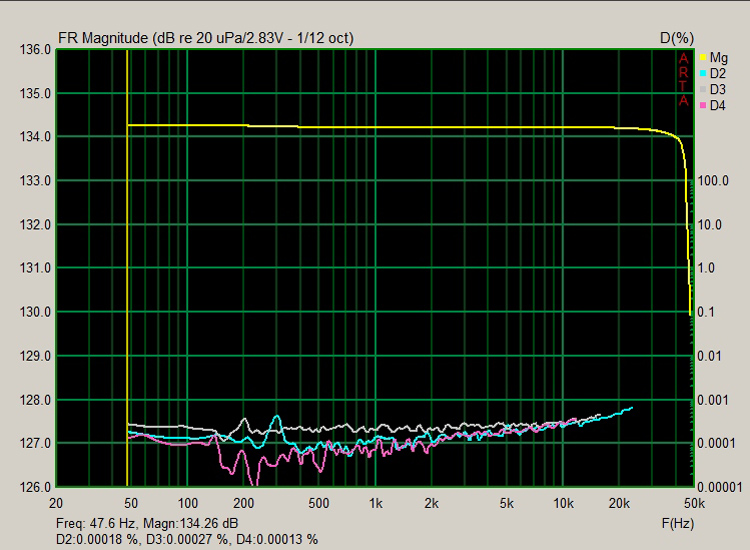
So, for the speakers, first, let’s take a look at the room response (different than an impulse response), on-axis, 2 meters, white noise, 81 dB. The room response includes reflections from the floor, wall, ceiling, and furniture in the room. It appears relatively flat to about 20 kHz and then it declines to 30 kHz. The low-frequency output is modest, and I would suggest that if you like to listen to deep, pounding bass, that you add a dedicated subwoofer to these speakers. It is really almost impossible to get high output in the 20-50 Hz region in a full-range speaker.

I turned the bass control on the rear of the speaker to the + position for the next test. Here is the resulting room response. The bass in the 30-50 Hz region has been boosted a few dB.

Moving 500 off-axis, the response shows some gain in the midrange, but attenuation above 16 kHz. Nevertheless, it is still quite listenable. This is a good off-axis response.
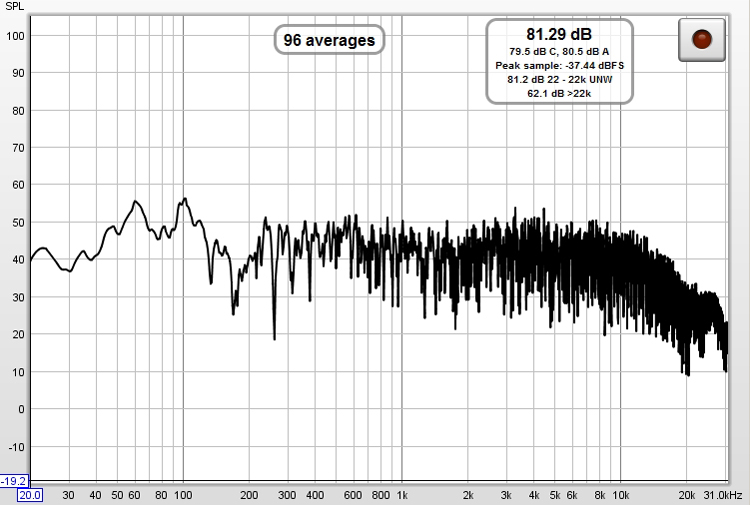
Compare the room response to an impulse response which allows us to remove most of the room effects to create a quasi-anechoic response. The volume in this test was very loud, probably louder than you would listen to music on most occasions, but even so, the distortion was kept at modest levels. The frequency response is the top-most yellow curve. The three curves at the bottom are 2nd, 3rd, and 4th harmonics respectively. Notice that the 2nd-ordered harmonic is the largest one throughout most of the frequency range. This is unusual, and is excellent because 2nd-ordered harmonics are euphonic (pleasing to the ears).
This spectrum has 1/3rd octave smoothing which is the standard smoothing method (https://www.prosoundtraining.com/2019/07/26/why-equalize-in-1-3-octave-bands/). It involves averaging the loudness value around neighboring values in 1/3rd octave groups. The large dips at 180 Hz and 325 Hz are suck-outs from the room. I believe the smaller dips at 650 Hz, 1,150 Hz, and 1,550 Hz are also room issues. Unless you are listening to music in an anechoic chamber, every room will have such issues.
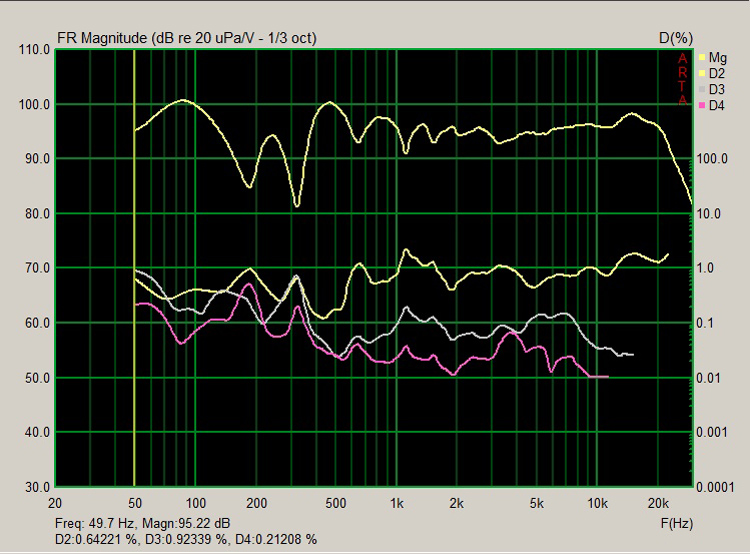
An impulse response is defined by Wikipedia: “In signal processing, the impulse response, or impulse response function (IRF), of a dynamic system is its output when presented with a brief input signal, called an impulse. More generally, an impulse response is the reaction of any dynamic system in response to some external change.”
In testing the Lilium speakers, it looks like this:
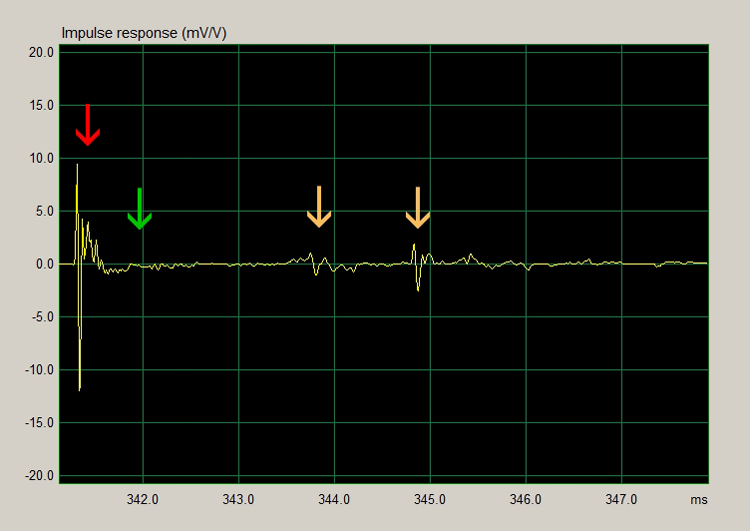
The analysis software sends full frequency range signals to the speaker (via the computer sound card output to the preamplifier, to the power amplifier, and to the speaker), the speaker reproduces the signals, the microphone picks up the signals and sends them back to the software.
In analyzing the signals, the software knows when it sent which frequencies. It “listens” for the first return of each frequency (the straight line from the speaker to the microphone, which is the shortest route) and plots that in the impulse response, indicated by the red arrow, shown above. The second, third, and any other returns are plotted following the impulse as reflections from surfaces in the room, such as the floor (likely the first one indicated by the orange arrow), wall or ceiling (the second orange arrow), and so on. Speaker enclosure and driver chassis resonances are indicated by the green arrow (see the resonance plot below).
So, the impulse response function allows us to separate the speaker’s direct sound from reflections of that sound coming from other surfaces in the room. It is not perfect, but it is the best we can do other than having an anechoic chamber.
The impulse response also can be used to plot the step response, which shows when each driver becomes active in relation to the other driver(s) when the signal voltage is initially applied. Below is the step response of the Sonus faber Lilium. The first peak on the left side is the tweeter, followed 0.23 ms later by the midrange and woofers (the midrange and woofers are the same size – 7”, and their summed output is larger than the single tweeter peak). 2.3 ms after the midrange driver is the subwoofer driver, followed by 1.7 ms later by the passive radiator. So, between the tweeter and passive radiator, there is a 4.23 ms delay. This shows you cannot fight the laws of physics. The reason there is delay is that the cones for the larger drivers have more mass, and therefore, it takes more time to “get them moving” when the signal voltage is applied. However, even though the passive radiator cone is the same diameter (10″) as the subwoofer cone at 10”, the passive radiator has to respond to the subwoofer movement rather than the directly applied voltage. So, the voltage is applied to the subwoofer, it moves, causing air pressure to change in the enclosure, and that change in air pressure then causes the passive radiator cone to move. Frankly, I am surprised there is only 4.23 ms in between the tweeter and passive radiator. That is just 4.23 thousandths of a second.

Analyzing specific frequencies, let’s take a look at a 1 kHz sine wave, 2 meters, 80 dB loudness. It has a second-ordered harmonic at 0.21% and subsequent harmonics are much lower. This means that the even-ordered 2nd harmonic is dominant, and that translates to a warm sound.

Looking at the 1 kHz sine wave on an oscilloscope shows how smooth it is. Both the positive and negative swings are identical, except for being the inverse of one another. This sine wave was reproduced by the midrange driver at 80.5 dB, 2 meters.
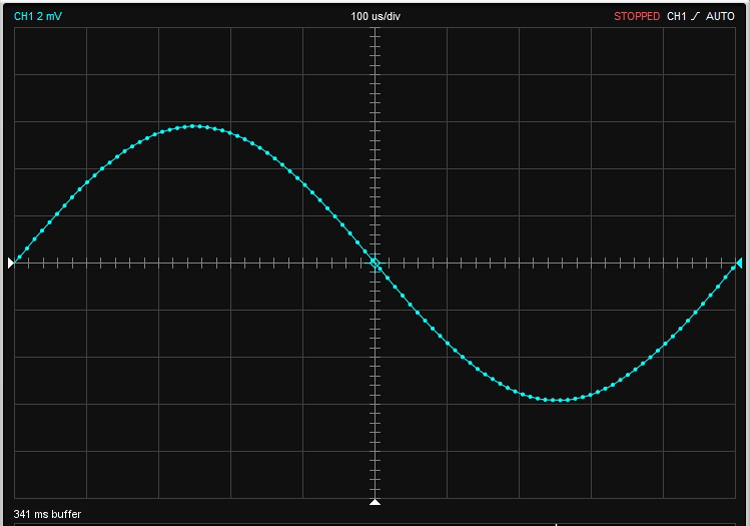
Here is 20 kHz, reproduced by the tweeter, 80.5 dB, 2 meters. Very accurate. Note that this is an analysis of the mechanical reproduction of sound by the movement of air from a cone rather than the movement of electrons in an electrical circuit. The positive portion of the waveform (the waveform above the middle horizontal line) is due to the cone moving out of the enclosure, pushing air towards the microphone. The negative portion (the waveform below the middle horizontal line) is due to the cone moving into the enclosure, pulling air away from the microphone.
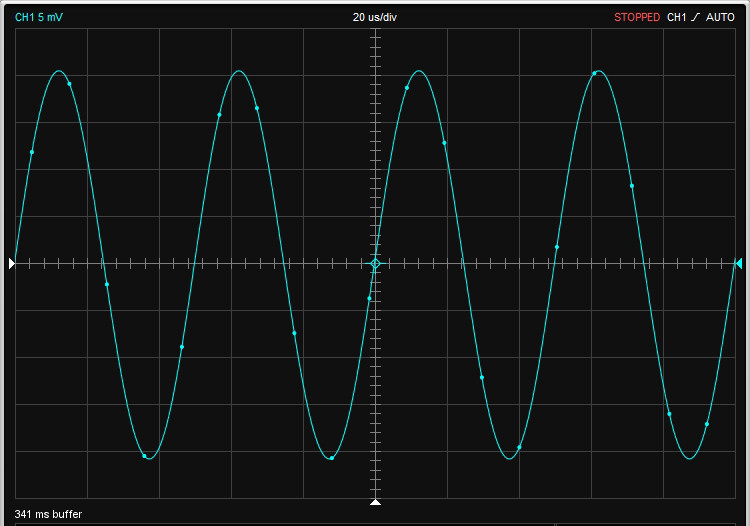
At 50 Hz, 80 dB, 2 meters, there is some irregularity in the waveform. This is expected. Deep bass is very, very difficult.

Resonance (vibration of the enclosure or driver that is not part of the musical signal) is always an issue. As mentioned previously, Sonus faber builds their speakers from MDF (Medium Density Fiberboard) rather than solid wood because wood is so resonant.
Below is shown a resonance waterfall, also called a Cumulative Spectral Decay, or CSD. Rise time is 0.2 ms. The red area in the rear is the frequency response of the speaker and is due to the desired output from the drivers. In front of that, at about 0.61 ms, is the beginning of the decay from resonance. It spans 350 Hz to 25 kHz and decays to about 2.75 ms with the last peaks at 3.5 kHz, 9 kHz, and 18 kHz. The resonance between 350 Hz and 1.8 kHz is from the cabinet. The resonance above 1.8 kHz is due to the drivers. Resonance takes 2.75 minus 0.61 = 2.14 ms. This is acceptable resonance for such a large cabinet with so many drivers.
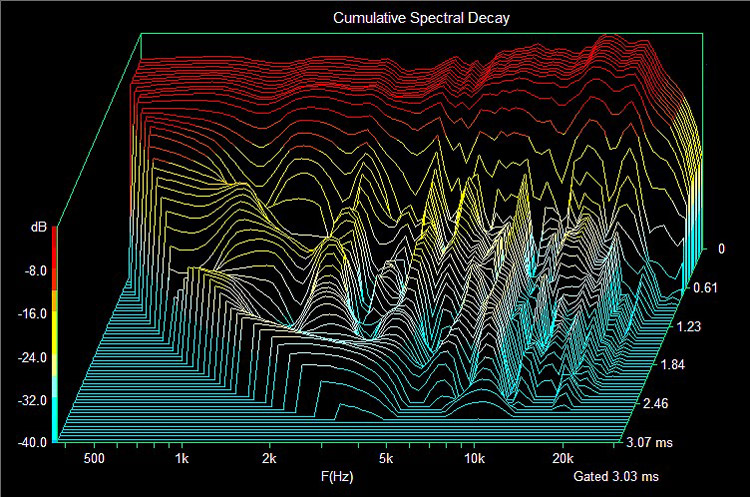
The electrical impedance/phase curve is shown below. The red curve is the impedance, and the blue curve is the phase. It can be seen that the impedance starts out at 4 ohms in the 10-100 Hz region, moves to 9.5 ohms at 180 Hz, then peaks at 15.2 ohms at 1.4 kHz before dropping back to 4 ohms at 7 kHz and above. The peaks and valleys are due to the crossover networks.
The phase fluctuates with the crossover networks as well and has a maximum positive phase of +400 at 125 Hz and a maximum negative phase of -420 at 2.1 kHz.
The Liliums are a relatively easy speaker to drive, but I would suggest having a minimum of 250 watts RMS per channel into 8 ohms just so you will have plenty of room to crank the loudness once in a while, leaving enough for dynamics without clipping.
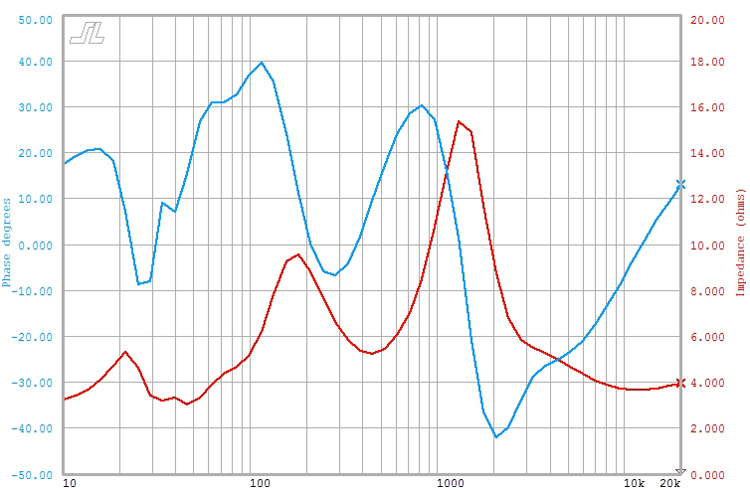
All of the bench tests represent an objective measurement of a product’s performance. We do this because subjective statements are based on the reviewer’s personal tastes in the sounds of music that are produced by the product under review. The bench tests bring a standard, objective point of view for product performance; however, it is not possible for us to bench test every product.
Bench tests do not necessarily directly represent what is heard and perceived because the human ear and brain “process” the sound to give an “effect” that the reviewer (and you, as listeners) perceives.
All audio components have distortion. Speakers have more distortion than CD players, preamplifiers, and power amplifiers because speakers mechanically move air while the other components move electrons. The Sonus faber Liliums have very low distortion.
The reviewer (me) perceives the Liliums as an extraordinary set of speakers. My wife said that she has never heard anything like them. I concur.
THE SONUS FABER LILIUM SPEAKERS are truly superb. They are beautiful, sound fantastic, and the spouse acceptance factor is outstanding.
- Incredible sound quality
- Beautiful enclosure
- Stellar construction
- Matching optional subwoofer with two inputs, three 10″ drivers, and 2,000 watt Class D amplifier
There is no such thing as the best speaker in the world, but the Sonus faber Lilium is definitely one of the best.
The Manufacturer Responds: Paolo Tezzon – Chief of Acoustics, Research, and Development for Sonus faber
In order to provide a comment to this wonderful Lilium review I would firstly like to provide you some clarifications:
The first one is pointing out that among the benefits about our D.A.D. (Stands for =Damped Apex Dome) trademark technology, hasn’t to be counted only – like you correctly highlighted – the “suppresses distortion that would otherwise result from the lag time that the front tip of the dome would have with respect to the rest of the dome moving back and forth with the high frequency signals” but also that – given the fact that the apex of the soft dome is no more behaving in anti-phase with the rest of the dome surface – the extension in the high frequencies results enhanced compared to the one typically available on a soft dome transducer. Basically the thinking behind on this technology was about improving the performance of the most natural sounding hi-frequency diaphragm (In our opinion), keeping its very good off axis dispersion (As highlighted by your 500 off-axis measurement) and its tone characteristic, while improving its ability in terms of extension which translates into more transparency, increased amount of inner details and richer harmonics contents. All of this has been perfectly pointed out by your listening impressions on the Elvin Jones record: “The sound here is typical of that era, with exact localization of each instrument in the stereo soundstage. I am a drummer (very amateur) myself, and Jones’ ride cymbal struck me with such clarity that I was truly astounded. A ride cymbal (any cymbal actually) has a very complex frequency structure, so it is no easy trick to reproduce. Wow!”
I’d also like to point out that the crossover frequency between the tweeter and the midrange is 2500 Hz, while the one between all 3 front woofers and the subwoofer is 250 Hz, more precisely: the midrange has a first order hi-pass set at 250 Hz, while the woofers have a third order Bessel low pass set around 220 Hz, low enough to avoid any bad iteration between them. It is also important to precise that the subwoofer is cut down at 80 Hz, with a 4h order Linkwitz-Riley filter but there is no hi- pass on the front firing woofers: they all run in parallel and they all contribute to reproduce the lowest frequencies. More they are loaded in separated enclosures: while the woofers are reflex loaded (Bottom firing…) the subwoofer is passive radiator loaded; but what really matters is the lack of any hi-pass for the front firing woofer, it’s just that the subwoofer is shut down quite soon and this keeps the midrange from merging with it. This is our “Staggered low frequency and this why Lilium is defined as a 3 and ½ way system.
Another important detail which requires to be clarify is about the enclosure: First of all the Lilium concept is about having two different separated and “viscous-elastically” decoupled enclosures: one for the main front firing transducers and another for the subwoofer. The first one is made out of two birch multilayered (12 layers per side) curved side panels: this material is very good in reducing resonances while the curved shape minimize (or almost erases…) inner reflections and standing waves; the structure is further reinforced by the use of aluminum “clamp-shelves” on top and bottom. The subwoofer enclosure is made out of extremely thick HDF (Extreme density sort of MDF) it is the most effective solution to create a “column loading enclosure” and there is no need to address internal reflections given the size of the wave lengths involved.
Finally, when it comes to “modest the low-frequency output, in the 20-50 Hz region” displayed by the measurements, I would suggest that performing measurements from 2m distance in a domestic environment is a tricky operation and not the best solution when it comes to understanding the real bass behavior of a loudspeaker system: you are dealing with long wavelengths and phase iterations with the environment so it might happen that the speaker are positioned in such a place that the low bass results cancelled…the mentioned atrium behind the speakers might not help and could possibly work as a bass trap (I saw this happening many times). So, what I would suggest in order to have a better understanding of what’s going on in that range of frequency is to do two different things:
- Perform the same exact 2m measurements with the speaker placed in a different spot
- Even more accurate, perform a “ground plane measurement”: it’s about laying on the floor the microphone at 1 or even 2 m away from the speaker and sweep the signal: the result is normally representative about what’s going on up to 100/120 Hz.
Of course in both cases it’s interesting to play with all 3 subwoofer’s emission level and see the differences.
Finally I really would like to underline how much your review was able to capture the aim laying underneath the Lilium design and development: reproduce music in the most natural and life-like way possible. In fact words like…
“I had Pepper’s sax sounding like he was playing in front of me, and to the left. The clarity and detail were simply stunning”
“I have never heard it with this level of instrument separation and room-filling volume”
“Playing it using the Sonus faber Lilium speakers was yet a new experience”
and
“It sounds like Brautigam has two pairs of hands. I never realized a pianist could play so fast. The Lilium’s capability to reproduce this at a life-like volume without audible distortion is simply amazing.”
…exactly expresses what we were committed to achive. Anytime we realize that our efforts are recognized by serious music lovers like you we feel extremely proud and we found our motivation strongly enhanced. Thank you very much.




